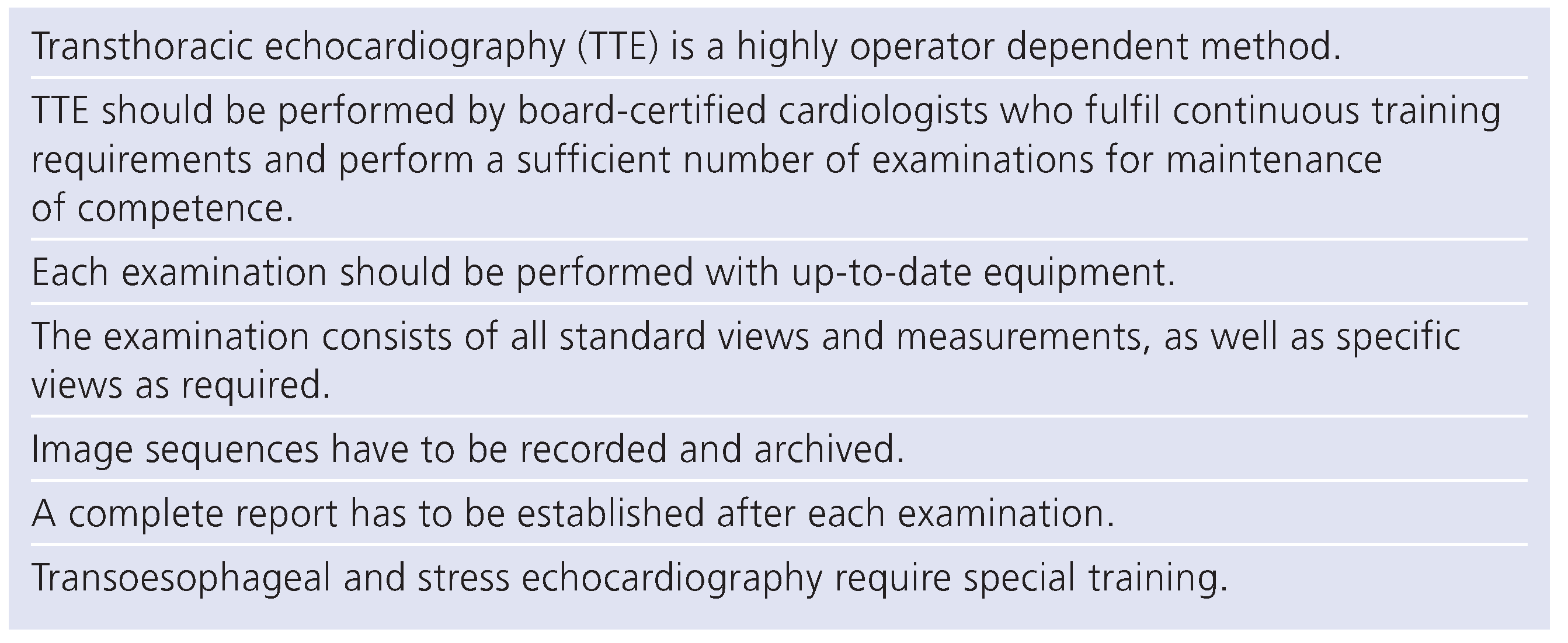Recommendations for Quality Maintenance in Echocardiography
Introduction
Equipment and imaging protocol
Training in echocardiography
Maintenance of competence
Transoesophageal and stress echocardiography
References
- Groupe de travail Echocardiographie; Société Suisse de Cardiologie. Directives pour la garantie de qualité en échocardiographie. Richtlinien zur Qualitätssicherung in der Echokardiographie. Kardiovaskuläre Medizin. 1999, 2, 50–55. [Google Scholar]
- Lang, R.M.; Bierig, M.; Devereux, R.B.; et al. Recommendations for chamber quantification: a report from the American Society of Echocardiography’s Guidelines and Standards Committee and the Chamber Quantification Group, developed in conjunction with the European Association of Echocardiography, a branch of the European Society of Cardiology. J Am Soc Echocardiogr. 2005, 18, 1440–1463. [Google Scholar] [PubMed]
- Mulvagh, S.L.; DeMaria, A.N.; Feinstein, S.B.; et al. Contrast echocardiography: current and future applications. J Am Soc Echocardiogr. 2000, 13, 331–342. [Google Scholar] [CrossRef] [PubMed]
- Writing Committee. Thomas, J.D.; Adams, D.B.; De Vries, S.; et al. Guidelines and recommendations for digital echocardiography. A Report from the Digital Echocardiography Committee of the American Society of Echocardiography. J Am Soc Echocardiogr. 2005, 18, 287–297. [Google Scholar]
 |
© 2009 by the author. Attribution - Non-Commercial - NoDerivatives 4.0.
Share and Cite
Vuille, C.; Jost, C.A.; Buser, P.; Jeanrenaud, X.; Lerch, R.; Seiler, C.; Trindade, P.T.; Zuber, M.; Writing Committee for the Swiss Society of Cardiology. Recommendations for Quality Maintenance in Echocardiography. Cardiovasc. Med. 2009, 12, 22. https://doi.org/10.4414/cvm.2009.01384
Vuille C, Jost CA, Buser P, Jeanrenaud X, Lerch R, Seiler C, Trindade PT, Zuber M, Writing Committee for the Swiss Society of Cardiology. Recommendations for Quality Maintenance in Echocardiography. Cardiovascular Medicine. 2009; 12(1):22. https://doi.org/10.4414/cvm.2009.01384
Chicago/Turabian StyleVuille, Cédric, Christina Attenhofer Jost, Peter Buser, Xavier Jeanrenaud, René Lerch, Christian Seiler, Pedro Trigo Trindade, Michel Zuber, and Writing Committee for the Swiss Society of Cardiology. 2009. "Recommendations for Quality Maintenance in Echocardiography" Cardiovascular Medicine 12, no. 1: 22. https://doi.org/10.4414/cvm.2009.01384
APA StyleVuille, C., Jost, C. A., Buser, P., Jeanrenaud, X., Lerch, R., Seiler, C., Trindade, P. T., Zuber, M., & Writing Committee for the Swiss Society of Cardiology. (2009). Recommendations for Quality Maintenance in Echocardiography. Cardiovascular Medicine, 12(1), 22. https://doi.org/10.4414/cvm.2009.01384




